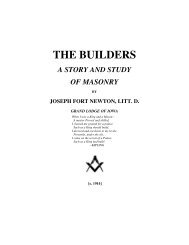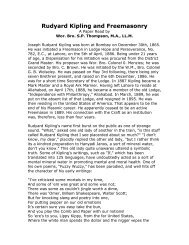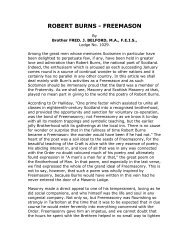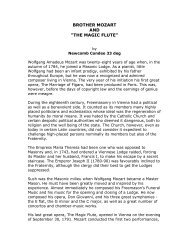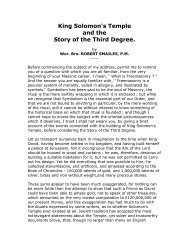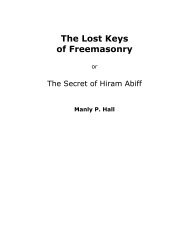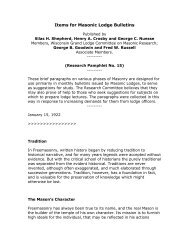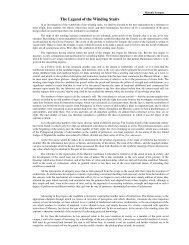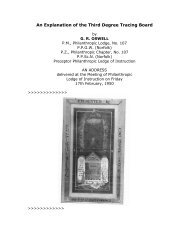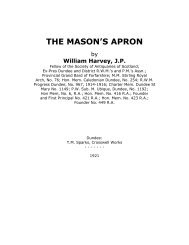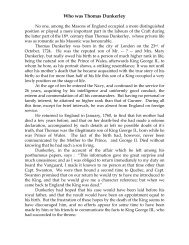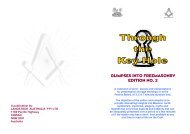You also want an ePaper? Increase the reach of your titles
YUMPU automatically turns print PDFs into web optimized ePapers that Google loves.
<strong>Masonic</strong> <strong>Legends</strong><br />
Roderick H. Baxter<br />
The purpose of this short paper -- written, by request, for the<br />
Transactions of the Dorset Masters Lodge -- is to call attention to some<br />
legends attached to the craft of Masonry, both Operative and<br />
Speculative, which require consideration and in some cases<br />
elucidation.<br />
To begin with, I might point out that the ritual, which we hear recited<br />
in our lodges, contains many statements that are either untrue or are<br />
very loosely made, as well as some assertions that are quite devoid of<br />
authority. I think we may regard these statements and assertions as<br />
being legends for our present purpose.<br />
Bro. T.W. Rowe, in a paper "Rowe versus Emulation," read before the<br />
Masters' and Past Masters' Association, Christchurch, New Zealand,<br />
dealt extensively with these, as well as with the grammatical errors<br />
and faults of literacy style which blemish our ceremonies; and again<br />
Bro. the Rev. W.W. Covey-Crump, in his installation address to the<br />
Quatuor Coronati Lodge, dealt extensively with the scriptural<br />
inaccuracies which have found their way into our ritual.<br />
It has been suggested, and not without reason, that these and other<br />
palpable mistakes of one kind and other are proofs of our descent from<br />
the working masons of old days, who handed down orally from<br />
generation to generation the secret lore of the craft. Nothing would be<br />
more likely to happen than confusion in this kind of transmission.<br />
Some Inaccuracies<br />
Perhaps before passing on to other legends I ought just to mention<br />
some of these inaccuracies in the ritual to which I have above made<br />
allusion. When we are told that a certain sign took its rise at the time<br />
Joshua fought the battles of the Lord in the valley of Jehosophat (or it<br />
may sometimes be Rephidim or Ajalon) we are quite at a loss to find<br />
scriptural authority for the statement. For something analogous to it,<br />
we can find in Exodous xvii, 8-13, an account of a posture adopted by<br />
Moses when he held up his hand so that Israel might prevail. A very<br />
fine picture by the late Sir John E. Millais, P.R.A., in the Manchester Art<br />
Gallery, depicts this incident, with Aaron and Hur supporting the<br />
Prophet's hands.
At another stage of our proceedings we say "And god said 'In strength<br />
will I establish this house,' " etc., but there does not seem to be any<br />
record of this in the sacred volume.<br />
Pillars, of one kind and another, play a fairly conspicuous part in our<br />
ceremonies, and those to which I would first of all call your attention<br />
were the two great pillars at the entrance to the Temple erected by<br />
King Solomon. We are accustomed to speak of them as the right and<br />
left hand pillars, but this must surely lead to confusion, for it is evident<br />
that everything depends on the point of view. Fortunately, we can<br />
dispel the difficulty for we read in II Chron. Iv, 10. "And he set the sea<br />
on the right side of East end, over against the south." As the entrance<br />
to the Temple was at the East end, over against the South." As the<br />
entrance to the Temple was at the East end, the positions of the pillars<br />
is thus clearly defined, and actually they are exactly opposite to the<br />
common acceptance. I believe the credit of having solved this problem<br />
belongs to Bro. J.T. Thorp, of Leicester, the able editor of the<br />
Transactions of the Lodge of Research, No. 2429.<br />
As to these pillars there is no authority for saying that they were<br />
formed hollow "to serve as archives for Masonry," not that they were a<br />
memorial of the miraculous pillars of fire and cloud that attended the<br />
Israelites in their wanderings. Nor, again, is there any mention in the<br />
Scriptures of these pillars being adorned with balls. And as to these<br />
balls having maps of the terrestrial and celestial globes, we can only<br />
say that to the best of our knowledge map-drawing was invented by<br />
Anaximander of Miletus, in the sixth century B.C.; even if Solomon did<br />
use maps centuries before they were known, he displayed a wonderful<br />
lack of wisdom in exhibiting them on pillars, which, at the lowest<br />
computation, must have been at least twenty-seven feet in height !<br />
The Old Charges<br />
In a wonderful series of old MSS. known by the title of Old Charges we<br />
have, amongst other things, a kind of history of the craft or story of<br />
the gild which is commonly called the Legend of the Craft. These old<br />
documents, which date from about the end of the fourteenth century,<br />
so far as transcription is concerned, but are necessarily of a much<br />
older origin, have been described as the title deeds of our fraternity,<br />
furnishing the necessary proofs of our antiquity. I cannot do better<br />
than give you a modernised transcript of my own for this legend,<br />
merely premising that it has been compiled, not from one MS. only,<br />
but has been made to embody the essentials of the whole series. It<br />
runs something in the following manner:--
Good Brethren and Fellows, our purpose is to tell you how and in what<br />
manner this worthy Craft of Masonry was first begun, and afterwards<br />
how it was mentioned and cherished by Kings and Princes and many<br />
other worshipful men; and to those that are here we shall declare the<br />
charges that every Freemason should keep. For the science of Masonry<br />
is a virtuous Craft, and well worthy to be kept, being one of the seven<br />
liberal arts and sciences which are as follow. The first is Grammar,<br />
which teaches man to speak and write correctly. The second is<br />
Rhetoric, which teaches man to speak in subtle terms. The third is<br />
Logic, which teaches man to discern truth from falsehood. The fourth<br />
is Arithmetic, which teaches man to reckon and count all numbers. The<br />
fifth is Geometry, which teaches man to mete and measure the earth<br />
and all manner of things and Masonry is of this science. The sixth is<br />
Music, which teaches man the craft of song and sweet sounds, and the<br />
seventh is Astronomy, which teaches man to know the course of the<br />
sun, moon and stars.<br />
Thus it may be proved that all the sciences of the world are grounded<br />
on the science of Geometry, for there is no trade or craft which does<br />
not work by mete or measure, nor does man buy or sell anything<br />
except by weight or measure, and especially do ploughmen and tillers<br />
of the soil work by the science of Geometry. None of the other<br />
sciences can enable man to carry on his trade or craft in such a way,<br />
wherefore we argue that Geometry is the worthiest of all sciences.<br />
We shall now tell you how this science was begun. According to the<br />
fourth chapter of Genesis, before Noah's flood, there was a man called<br />
Lamech who had two wives, one called Ada and the other Zillah. The<br />
first wife Ada bore him two sons, Jabal and Jubal, and the second wife<br />
Zillah bore him a son and a daughter, tubal-Cain and Naamah. These<br />
four children found the beginning of all the crafts in the world. Jabel,<br />
the eldest son, found the craft of Geometry, and he was the first<br />
person to divide lands and flocks of sheep and lambs, and he was also<br />
the first to build a house of wood and stone. Jubal found the craft of<br />
Music, Tubal-Cain the craft of the Smith and Naamah the craft of<br />
Weaving. Now these children knew that God would take vengeance<br />
upon the earth, either by fire or water, and in order that their<br />
discoveries might be preserved to future generations they wrote them<br />
upon two pillars of stone; on of marble, which would not burn in fire,<br />
and the other of lattress, which would not drown in water. After the<br />
destruction of the world by flood, Hermes, who has been called the<br />
Father of Wise Men, found one of the pillars and taught the sciences<br />
written thereon to other men. At the building of the Tower of Babel,<br />
masonry was in great repute, and Nimrod, the King of Babylon, was
himself a Mason and a lover of the craft, so that when Nineveh and<br />
other cities of the East were about to be built, he sent thither three<br />
score masons at the request of his cousin, the King of Nineveh, and<br />
when they went forth he gave them a Charge in this manner:-- That<br />
they should love each other truly, in order that no discredit should fall<br />
on him for sending them, and he also gave them a charge concerning<br />
their science. These were the first Masons who ever received any<br />
charge. At a later date when Abraham, with his wife Sarah, went into<br />
Egypt he taught the seven sciences to the Egyptians, and he had a<br />
worthy scholar called Euclid, who made profitable use of his<br />
instructions. In these times it happen ed that many Lords and other<br />
great men of the realm had so many sons, some by their wives and<br />
some by other ladies, for that is a hot country and plenteous of<br />
generation, that they had not sufficient means to maintain them.<br />
So the King of the Country called a Council together and caused a<br />
parliament to be held to ascertain if any scheme could be devised to<br />
remove the difficulty. After full consideration they issued a<br />
proclamation that if anyone could inform them of any cunning art or<br />
science which would be of any avail he should be richly rewarded.<br />
Euclid, therefore, came before the King and his Council and offered, on<br />
condition of being appointed by commission to rule over them, to<br />
teach their sons the seven liberal sciences. The commission having<br />
been granted, Euclid took these Nobles' sons and instructed them in<br />
the science of Geometry and how to apply the knowledge to all<br />
manner of worthy works, such as the building of castles, churches,<br />
manors, towns and houses, and he gave them Charges similar to those<br />
which Nimrod had given in Babylon, with the addition of others which<br />
would take us too long to describe; and he made them swear a great<br />
oath, which men used at that time and gave them reasonable wages<br />
that they might live honestly. And he also arranged that they should<br />
assemble annually in order that they might take counsel together and<br />
settle any points in dispute, and how best generally to advance the<br />
interest of the craft.<br />
Long afterwards, when the Children of Israel were come into the Land<br />
of Behest, which we now call Canaan, King David began to build the<br />
Temple of the Lord, and he loved Masons well and gave them Charges<br />
as Euclid had done in Egypt. And after the death of David, his son<br />
Solomon completed the temple which his father had begun, and he<br />
sent for masons into divers towns and countries, and gathered<br />
together twenty-four thousand men, of whom one thousand were<br />
ordained to be governors of work. And there was a King of another<br />
country whose name was Hiram, and he loved King David well and
gave him timber for his work, and he had a son name Aymon, who<br />
was a master of Geometry and chief of all Masons and of all graven<br />
and carved work belonging to the Temple, as related in the First Book<br />
of Kings.<br />
Skilful craftsmen walked abroad in different countries, some to learn<br />
more science and others to spread the knowledge they had already<br />
gained, and it happened that there was a curious craftsman named<br />
Naymus Graecus who had been at the building of King Solomon's<br />
Temple, and he went int France and there taught the craft to Charles<br />
Martel, who afterwards became King of that country. Charles took<br />
upon himself the charges of a mason, and for the love he bore to<br />
masons he set many of them to work and gave them good wages and<br />
ordained for them an annual assembly as previously related for<br />
masons in Egypt.<br />
England at that time stood void of any charge of Masonry, but when<br />
St. Amphibal came out of France he converted St. Alban to<br />
Christianity. The King of England at that time was a pagan, and he<br />
walled the town of Veralum, which is now called St. Albans, round<br />
about, and St. Alban, who was a worthy Knight, was chief steward to<br />
the King, and had the government of the realm and also the making of<br />
all walls, towers and other works, and he loved masons well and<br />
cherished them much and made their pay right good, considering the<br />
times, for he gave them thirty pence a week with three-pence a day<br />
for their noon-findings, for at that time a mason took but a penny a<br />
day and his meat, and he gave them charges which St. Amphibal had<br />
taught him and they differ but little from the charges in use at this<br />
day. Soon after the death of St. Alban grievous wars disturbed the<br />
realm and the good order of Masonry was destroyed, until the time of<br />
King Athelstane, who brought the land to rest and peach and erected<br />
many abbeys, castles, and other buildings, and he had a son called<br />
Edwin, who loved Masons even more than his father did, and was a<br />
great practiser of Geometry and communed much with Masons, and he<br />
was afterwards made a Mason himself, and he obtained from the King,<br />
his father, a charter that they might hold every year an assembly<br />
wheresoever they wished within the realm, that they might correct any<br />
faults, errors, or trespasses concerning their craft. Edwin himself<br />
presided over a great assembly of Masons at York, and he there made<br />
Masons, and he ordered all who had any writing concerning masonry<br />
to produce them, when some were found to be in Latin, some in<br />
Greek, sone in French and some in other languages; but the meanings<br />
were all one, and he caused a book to be made thereof telling how the
craft was found, and he commanded that it should be read whenever<br />
any Mason should be made and that he should be given his charge.<br />
Right worshipful masters and fellows who have been at divers<br />
assemblies from time to time since then have ordained and made<br />
other charges according to the necessities of the times, and these<br />
charges have been seen and perused by our late Sovereign Lord Henry<br />
VI and the Lords of the honourable Council who have approved them<br />
and agreed that they were good and reasonable. And the good rule of<br />
masonry obtains to this day, the charges being descended through the<br />
various channels described in the foregoing narrative.<br />
The manner of taking the oath at the making of Masons:--<br />
Tunc unus ex senioribus teneat librum et ille vel illi ponant manus<br />
supra librum tunc praecepta deberunt legi. [then one of the elders<br />
shall hold out a book and he or they (who are to be made masons)<br />
shall place his or their hands upon it and the following precepts shall<br />
be read].<br />
"Every man that is a Mason take heed right wisely to these Charges, if<br />
you find yourselves guilty of any trespasses amend your errors against<br />
God, for it is a great peril to forswear yourselves upon a book."<br />
As you will easily observe, this is a perfect farrago of nonsense so far<br />
as history and chronology are concerned. Nevertheless, it is not<br />
without interest of value; and I have myself in a paper on the Old<br />
Charges and the ritual read before the Q.C. Lodge in 1918, tried to<br />
develop a theory that it has served as a basis for our ritual, not only so<br />
far as the general run of our ceremonies is concerned but in many<br />
cases as to the actual verbiage.<br />
Quatuor Coronati and Other <strong>Legends</strong><br />
An examination of the legend will reveal that running through it are<br />
quite a number of subsidiary legends, which have been dealt with at<br />
various times by diligent students. I might specially mention the<br />
Naymus Graecus legend and the Prince Edwin legend which have been<br />
specially handled from time to time int he pages of A.Q.C.<br />
And this, quite appropriately, brings me to the legend of the Quatuor<br />
Coronati itself. There are various accounts of this to be found in old<br />
MSS, but, so far as our purpose is concerned, we cannot do better<br />
than consult the Oration delivered at the Consecration of the Quatuor
Coronati Lodge by the late Bro. The Rev. A.F. Woodford and the By-<br />
Laws of the same Lodge which embody the story as unfolded by the<br />
first Secretary, the late Br. G.W. Speth.<br />
It really seems, then, that the title Quatuor Coronati embraces two<br />
groups of Saints, one comprising five craftsmen and the other four<br />
soldiers in the roman army, who suffered martyrdom in the time of the<br />
Emperor Diocletian, and whose festival is now dated in the calendar of<br />
the Church of Rome on the 8 th November -- the day appropriately set<br />
aside for the installation meeting of the Lodge. The mason martyrs<br />
were named Cladius, Nicostratus, Symphoranius and Castorius, with<br />
an artisan, Simplicius; and the soldiers were Severus, Severianus,<br />
Carpophorus and Victorinus. The martyrdom of the first group has<br />
been assigned to A.D. 296 or 302, and of the second to 298 or 304. I<br />
need not delay you with details of their offences, nor the methods of<br />
their deaths. It is sufficient for our purpose that they suffered and died<br />
for their faith.<br />
And, turning now to the question of the Mason-word, which may<br />
possibly lie within the compass of a paper of this kind, we know from a<br />
poem named "The Muses Threnodie," by henry Adamson, M.A.,<br />
published at Perth in 1638, that the word existed at least as early as<br />
that date, for, along with other significant allusions, we have the<br />
couplet:-<br />
For we be Brethren of the Rosy Cross<br />
We have the Mason-word and second sight.<br />
Again, in the year 1652 the Presbytery of Kelso sustained the action of<br />
the Rev. James Ainslie in becoming a Freemason declaring there was<br />
"neither sinne nor scandale in that word" -- meaning the Mason-word.<br />
It has been stated frequently that this word has been lost, and that we<br />
have now no idea what it was, but some students incline to the idea<br />
that the indications are sufficiently clear to enable us to form a very<br />
shrewd guess. Here I cannot be very explicit. I must only guardedly<br />
hint that it was a word of omnific power.<br />
The Death of the Builder<br />
As to the Hiramic Legend -- the most important, perhaps, of all our<br />
legends -- it is only possible to say that there is no direct reference to<br />
it in the V.S.L. Nevertheless, Bro. The Rev. Morris <strong>Rose</strong>nbaum has<br />
endeavoured to shew in a paper, "The Two Hirams," that although the
death of the builder is not specifically mentioned in the Bible, there<br />
were really two Hirams -- father and son -- one of whom was the<br />
designer, or architect, of the building and the other the mere artificer<br />
who cast the pillars and vessels of brass. The former was dead -- by<br />
what means we can only guess -- when the latter completed the work.<br />
In Ezekiel xxvii we have an account of the slaying of the Prince of<br />
Tyre, who has been suggested as the second of the G.Ms. at the<br />
building of the Temple, and again in I Kings, xii, 18, we read of the<br />
murder of Adoram, who is elsewhere referred to as Adonhiram, by the<br />
mob. I dare not in this mode of communication say more.<br />
Very significant concerning our third step in Freemasonry are two<br />
proper names to be found in I Chronicles ii, 49, and xii, 13, especially<br />
when studied in connection with the tables of proper names, not only<br />
in connection with the Genevan version of the Bible, but in some<br />
modern concordances. I should like to suggest that we continue to use<br />
in our workings, in view of this evidence, the old expression, "the<br />
builder is smitten," in preference to the modern one "the builder is<br />
slain."<br />
I might here mention that corruptions of the words I am hinting at are<br />
to be found in early prints and writings, some of which may fairly be<br />
claimed as being of pre-Grand Lodge date.<br />
This legend of the death of the builder is worth considering in<br />
connection with features in many notable buildings, the most<br />
important of which is perhaps that of the Prentice Pillar in Roslin<br />
Chapel, near Edinburgh. Here we have a story so closely approaching<br />
our own Hiramic Legend that we cannot help associating the two. Nor<br />
can we imagine that the story has been invented after the erection of<br />
the structure, for we have in addition to a subsidiary pillar known as<br />
the master's, carvings of the widow's head, the Master-mason's head<br />
and the Apprentice's head with the wound on the forehead. Other<br />
examples may be found in the Apprentice bracket at Gloucester, the<br />
fine wheel window at Lincoln and several others, all involving the same<br />
general idea -- the death of the master-mason, or chief builder, or the<br />
apprentice of skill, who certainly technically died as an apprentice to<br />
rise as a master of his craft. Nor, I think, should we neglect the<br />
attitudes of certain carved figures of which I shall now only<br />
particularise a boss on the vaulting under the parvice at Peterborough.<br />
Benhadad's Escape
In I Kings, xx, we have an account of the defeat of Benhadad, King of<br />
Syria, by Ahab, King of Israel, when the former was taken captive and<br />
would in the ordinary course of events have been put to death, but<br />
intercessions occurred with favourable results for we read: "So they<br />
girded sackcloth on their loins and put ropes on their heads and came<br />
to the King of israel and said. They servant Banhadad saith, I pray<br />
thee let me live. And he said - IS he yet alive? He IS my brother. Now<br />
the men did diligently observe whether ANYTHING WOULD COME from<br />
him and did hastily catch IT: and they said Thy brother Benhadad.<br />
It would, of course, be going too far to suggest that we have here an<br />
example of a masonic sign having saved a man's life, but for what the<br />
incident is worth I think it worthwhile placing it on record in this paper<br />
on legends.<br />
Before drawing to a conclusion, I might class as legends the various<br />
subterfuges adopted by Brethren to conceal their lack of <strong>Masonic</strong><br />
Knowledge. Many of these have been brought to my notice. A wellknown<br />
brother asked me about certain peculiar characters on the Third<br />
Degree T.B. He was told by P.Ms. that he could not have any<br />
explanation until he had reached the chair. After his installation he was<br />
fobbed off with the excuse that the explanation could only be given to<br />
R.A. masons, and them, when he had attained that rank, he was<br />
assured that he would need to wait until he had passed the first<br />
Principal's chair. All of which is very pathetic, for really any novice with<br />
the aid of the <strong>Masonic</strong> cipher, with its several variations and<br />
inversions, can quite readily decode the harmless characters. And this<br />
brings me to the meaning of the three figures 5 on the coffin. We are<br />
all inclined to view subjects from our own standpoint. Being<br />
accustomed to read plans on which levels can only be indicated by a<br />
figure, I for long assumed that they referred to the DEPTH of the<br />
grave, for we are instructed "there in a grave from the centre three<br />
feet east and three feet west" (that is to say six feet long) "three feet<br />
between north and south" (three feet wide) "and five feet of more<br />
perpendicular" (five feet -- or more -- deep). On mentioning this to a<br />
brother architect, he disagreed with me and said, that in his opinion,<br />
the figures referred to the three groups of Fellow-crafts who were sent<br />
in search of the missing G.M. But a little later in the day, whilst<br />
discussing the matter with Bro. Songhurst, the erudite Secretary of the<br />
Quatuor Coronati Lodge, he informed me that the figures had arrived<br />
by a process of evolution. On early boards, or cloths, the marks of the<br />
feet were shewn so that candidates might take the steps correctly.<br />
Later these foot-marks were replaced by two inclined lines resembling
the Roman numeral V, and from this it was easy to imagine how the<br />
Arabic numeral 5 came to be substituted.<br />
Thus far have I carried my rambling remarks, and it is evident that my<br />
paper is more tentative or suggestive than in any way complete. I<br />
must, therefore, endeavour to close with a suggestion as to the<br />
meaning of our system, and it is no less than this. Nature has<br />
implanted in the breast of man a hope that when he has finished with<br />
this mortal existence something remains for him in a future state. All<br />
the mysteries that ever existed have taught the story of a birth, a<br />
death and a resurrection or regeneration -- even the Christian faith is<br />
no exception to this rule -- and therefore it is no wonder that the<br />
Masons of old, who were engaged in the erection of actual temples,<br />
should have transmitted to their Speculative successors, who are<br />
engaged in the erection of spiritual temples, the tradition or legend of<br />
a glorious faith in immortality.<br />
S.M.I.B.<br />
Extracted from:<br />
British <strong>Masonic</strong> Miscellany, Vol 15<br />
compiled by<br />
George M .Martin P.M., S.C.<br />
Published by<br />
David Winter and Son<br />
Shore Terrace, Dundee (Scotland<br />
(Pages 122-135)



